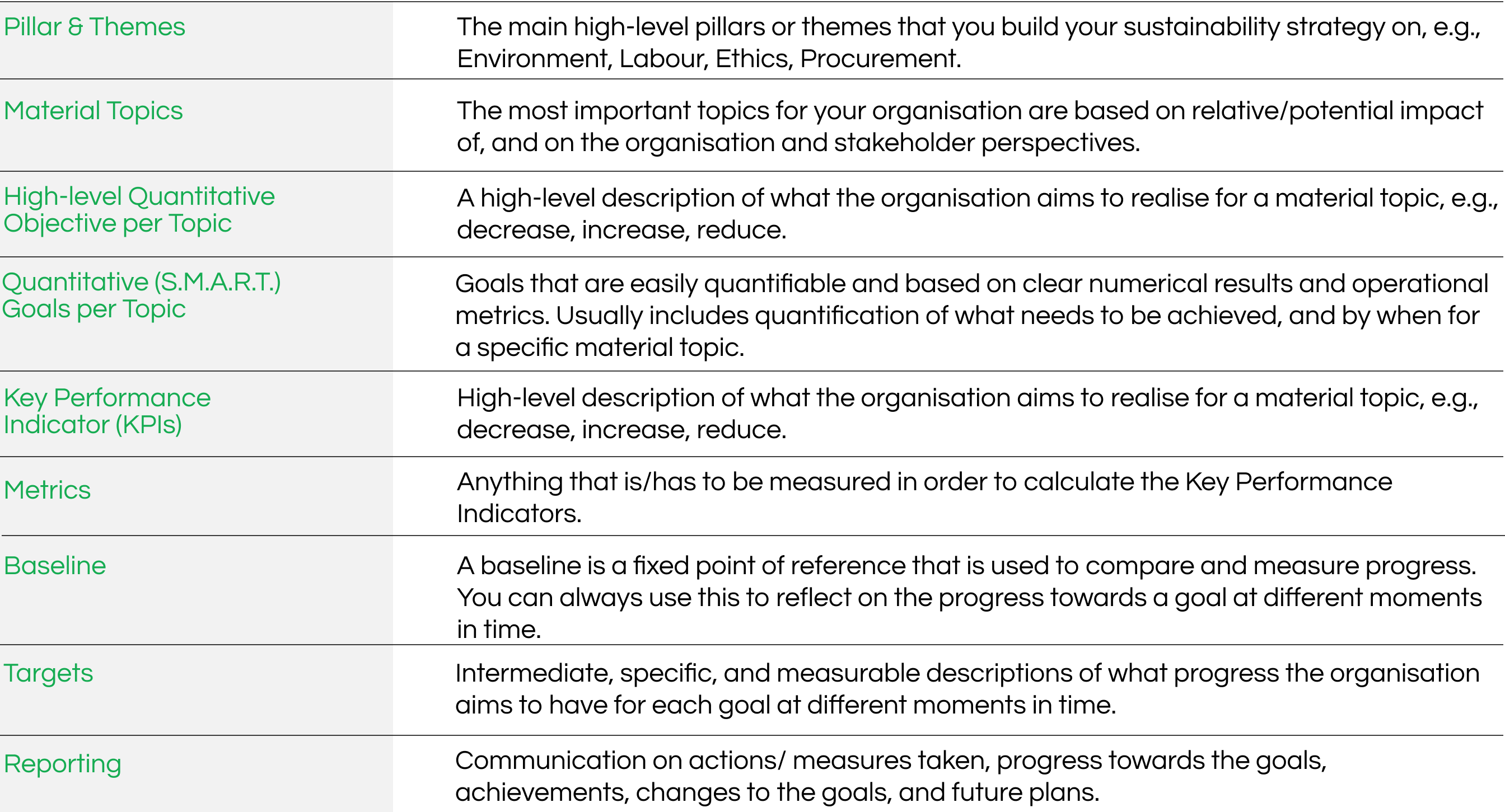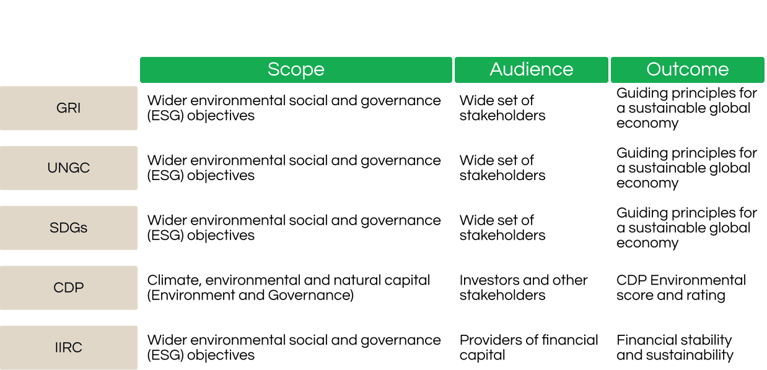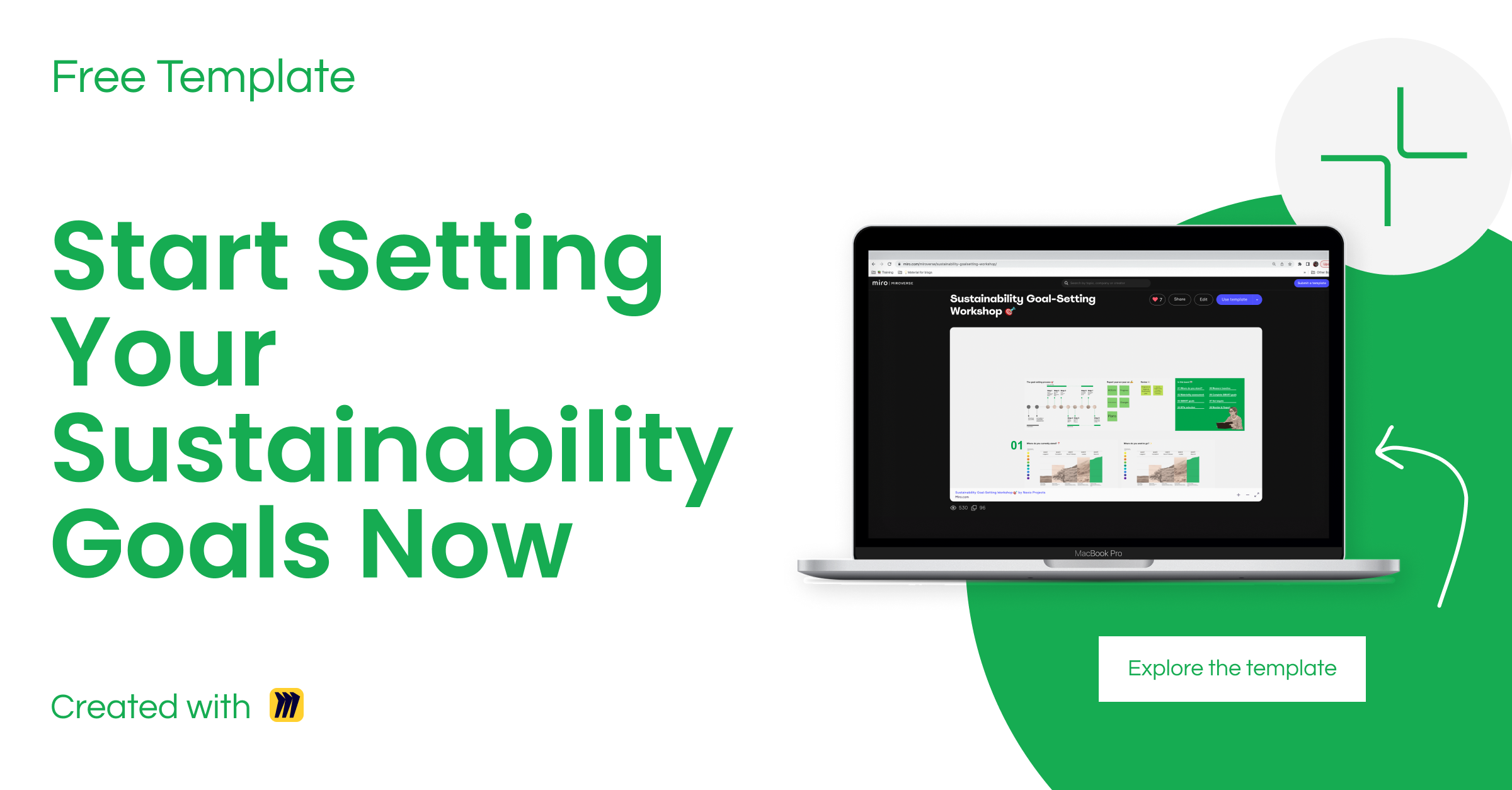The Ultimate Guide to Setting Sustainability Goals

Introduction
What is a Sustainability Management System?
It is becoming increasingly rare to find an organisation that doesn’t engage in some form of sustainability.
Almost everyone has some elements of a Sustainability Management System (SMS) in place.
Before we dive into how organisations can concretely understand, define, set, and report on their sustainability goals, let’s first grasp the wider strategic and structural context in which organisations operate.
At the core of this context, is a Sustainability Management System. This can be understood as a consciously defined and systematic approach to evaluate, manage, and improve organisations’ sustainability strategies.
An organisation’s mission, vision, values, and allocatable resources strongly influence its approach to the creation of an SMS. This naturally translates to what extent goals are set, tracked, and reported on. It’s important to note that Sustainability Management Systems and the setting of goals is not linear, nor a tick-in-the-box exercise.
What are sustainability goals?
When talking about sustainability goals most people’s minds instantly jump to the United Nations Sustainable Development Goals (SDGs). The SDG framework forms a vital part of the international sustainability agenda. But there is much more to corporate sustainability goal setting.
Sustainability goals can generally be understood as:
Future-looking , either quantitative or qualitative measurable actions, aims or objectives that organisations set across various pillars of sustainability.
Before we can discuss how to approach goal setting, let's first break down the types of goals and what they entail. These goals can be split into two broad overarching categories, either quantitative goals or qualitative goals. Let’s start by dissecting these categories of goals a bit further.
Qualitative goals
Qualitative goals are goals that act as a descriptive indication. They speak to what an organisation aims to achieve in relation to a specific material topic.
Qualitative goals are often defined as being subjective and non-measurable, or that they are more “felt rather than measured”. However, this doesn’t necessarily always need to be the case.
While these may be true in certain circumstances, qualitative goals can be specific and informative. These often give more insight, context, and an indication of an organisation’s values and intentions. More so than a “measurable” and perhaps more tangible quantitative goal.
When setting goals, accurate phrasing and precise word choice are always important. This is even more relevant when setting qualitative goals, given their non-numerical nature.
Quantitative goals
Quantitative goals are those that are most often publicly set and communicated by organisations. These are easily measurable and based on clear numerical results or operational metrics. They are often perceived to be more easily evaluated and understandable than qualitative goals.
Download the free guide to get practical examples of qualitative and quantitative goals.
Goal Setting Frameworks
The difference between quantitative and qualitative goals is clear. Now, we can move on to what elements make a strong and well-defined goal. How you choose, formulate, and define your goals is one of the most important steps throughout the entire process.
The S.M.A.R.T. Framework
Ensuring that the goals are well-defined and conforming to a framework means that you are already halfway to success. Luckily, there are well-known frameworks to help guide and structure the formulation of goals. The first and arguably most used is the S.M.A.R.T. framework.
The S.M.A.R.T. framework aims to ground organisations in practicality and tends to lean towards emphasising feasibility and realism. In fact, one of the criteria of S.M.A.R.T. goals is ‘achievability’, thus favouring more realistic objectives. Now, let's dive a bit more in-depth into each of the criteria.
Specific
Without being as specific as possible, a goal will not be effective. It needs to be immediately clear to whoever reads it what the core issue or aim is.
What do I want to achieve?
Why do I want to achieve this goal?
Why is it important?
Who is involved?
Measurable
This relates to the quantifiability and tangibility of the goal. According to this principle, progress on this goal should be possible to measure and track over time.
How will I measure my progress?
How will I know if and when my goal has been achieved?
Achievable
Find a good balance between setting realistic and challenging goals. That is what this point is all about. According to the S.M.A.R.T. Framework, your goals should be challenging enough, while also being reachable so that the team feels motivated to put in the work.
How can I accomplish this goal?
Do I have the needed resources to achieve this goal?
Is this goal realistic?
Is it within my abilities?
Relevant
This is the moment to think back on where you see the goal fitting within your sustainability strategy and ask yourself why you’re setting this specific goal.
Is this the right time?
Is it worthwhile?
Does this goal match our team’s needs?
Time-bound
Having a clearly established time horizon allows for a practical sense of tangibility and transparency. This not only goes for external accountability purposes but also for internal stakeholders. The latter need to work on tasks and projects to achieve the goal at hand. A clearly defined and timely goal allows for increased alignment, adaptability and makes it easier for teams to coordinate their actions.
How much time will I need?
How much progress should I have done in one month/quarter/year from now?
Start setting your sustainability goals with our S.M.A.R.T. Framework template now!
The D.U.M.B. Framework
If you prefer to use goal setting as a motivational and idealistic push to spur change, then the D.U.M.B. can be more appropriate for you.
This is not to say that setting S.M.A.R.T. goals can’t have this effect on organisations. However, as we said before, the feature of ‘achievability’ favours realistic objectives.
On the other hand, D.U.M.B. goals are meant to draw less on realism and more on leveraging inspiration and ambition. These goals are framed to demonstrate the purpose the organisation aims to serve beyond its community and contribute on a global scale.
Dream-Driven
Goals should represent where an organisation wants to go. There is no shame in dreaming big and incorporating a passion to show set aspirations.
Uplifting
A goal needs to be inspirational and uplifting for those who see it and contribute towards it. A truly inspiring goal affects not only the organisation and its people. It inspires competitors, and industry-adjacent organisations to do better.
Method-Friendly
To realise big dreams and uplift those working towards the set goals, proper planning is vital for achievement and success. It's important to understand the methods and processes that will get you where you want to go.
Behaviour-Driven
A goal shouldn’t be just a number or target that feels distant and far-removed. It should relate to the organisation’s culture, daily operations and work ethic. A goal should cover all of these elements. And employees should work with the goals in mind on a day-to-day basis.
While we have presented two seemingly contrasting frameworks, they don’t need to be mutually exclusive. There is no ‘best framework’. It entirely depends on the level of ambition of the organisation that wants to set goals.
In addition, another aspect that should be considered is which approach fits better with your team and organisation. Think of the existing strategy, organisational DNA, culture and vision for the future in terms of growth and sustainability. In this sense, it’s important for organisations to ask themselves a few seemingly simple, but key questions:
What gives you energy?
How do you approach reaching goals?
What does success look like for you?
A step-by-step goal-setting process
Before we get started presenting the step-by-step approach to setting sustainability goals, let's clarify some key terms that we'll use throughout the remainder of the article.

As you may notice, there are multiple relationships of (inter-)dependence between these different terms. This means that you have to do certain things before you can determine underlying or nested elements.
For example, if you are unclear about the pillars you use, it is difficult to identify all (potentially) material topics. If you do not have an overarching goal for your pillar, you cannot align the qualitative objectives of your material topics.
In turn, you cannot align your quantitative goals with them either. If you do not know your S.M.A.R.T. quantitative goals, you cannot determine the right KPIs.
In other words, you cannot identify which metrics have to be tracked. If you do not know your quantitative goals or lack information on your baseline, it is difficult to set appropriate targets.
Now that the terminology is clear, we can move forward with the goal-setting process.

Step 1 - Define overarching principles, pillars & framework
For each pillar, define an overarching principle to set the direction that the organisation pursues/strives for. Make sure to phrase this in a qualitative and broad way so that it acts as an umbrella over the more concrete objectives and goals set for each material topic.
Corporate sustainability is a continuously evolving concept and also growing in popularity. As a result, there are a number of frameworks that structure it into high-level and actionable pillars. Within these pillars, you can then set goals and targets and track relevant KPIs.
Below, we present an overview of the most reputable and commonly used frameworks.
They can be used to shape the core of organisations’ sustainability strategies.

Step 2 - Set high-level objectives & topics
For each material topic of your organisation, you need to then set a high-level objective. This can be as simple as “Reduce energy consumption and CO2 emissions”, or “Minimise incidents that cause physical harm to employees”.
Do you want to learn more about how the concept of materiality applies to goal-setting?
These High-Level Objectives serve to align the concrete S.M.A.R.T. goals with the overarching principle of the pillar.
Step 3 - Draft S.M.A.R.T. (Quantitative) Goals
Next, you want to draft concrete and S.M.A.R.T., quantitative goals for each material topic. The emphasis here is on “draft”. You cannot yet fully complete them without having defined your KPIs and made a baseline for them.
The completion of the goals happens in step 6. For now, determine what goals you want to set, and leave the exact number (#), percentage (%), or year (20XX) empty.
First and foremost, organisations should set a timeframe and deadlines for the achievement of their sustainability goals. Having a deadline helps to plan actions and strategies over time. Targets can be intermediate or long-term.
Step 4 - Define relevant KPIs
Now that you understand the goals you will set, you can define the KPIs that need to be measured. KPIs help you to determine whether and how much progress you make towards achieving your goals.
Once again, the emphasis is on ‘define’. This means determining what it is that you will need to measure, not immediately measuring it.
Step 5 - Measure KPI Baseline
After you have a good overview of the KPIs, it is time to create a baseline measurement.
This means gathering information and data to calculate your KPIs for the year “0”. As the current year is not yet completed, you can choose to look at the previous year as your base year.
This baseline will serve as a reference for any increase or decrease in numbers or percentages. This is defined in your S.M.A.R.T. goals.
Step 6 - Complete SMART Goals
After making a comprehensive baseline of your KPIs, it is time to complete the SMART Goals. The emphasis is now on “complete”, as we already determined them in step 3.
This means you can replace the “XX” placeholders with actual numbers.
Make sure to set goals that are:
- Achievable enough to make progress and celebrate success;
- Inspiring enough to be challenging;
- Invite innovation and collaboration to achieve the goals.
At this point, you might be wondering if the same applies when developing a climate reduction strategy.
Step 7 - Set targets Year-Year
Now that you have completed the S.M.A.R.T. goals and know what you want to achieve. You can break down the bigger goals into year-on-year targets.
Targets are descriptions of what progress organisations aim to have for each goal. They are:
- Either intermediate or long-term;
- Measurable descriptions;
- Sequential.
They are a deadline for achieving (part of) your goals. Having a deadline helps companies effectively plan their actions and strategy over time.
Step 8 - Monitor KPIs & report Year-Year
To keep track of your progress, you need to collect data on all KPIs. Do this yearly or even more frequently. It is important to report, both internally and externally. Communicate your achievements and be transparent with relevant stakeholders to maintain engagement and trust in the process.
You should then compare the achieved results and the initially set targets. This will lead to further decisions concerning the level of attention and action you should dedicate to that particular goal.
Therefore, monitoring and reporting KPIs both internally and externally, are vital in the iterative cycle of strategy development.
This is to keep track of the progress towards the goals that have been set. To properly understand the importance of monitoring and reporting, it's necessary to zoom into what internal and external reporting is.
Internal Reporting
When most people think of reporting sustainability progress, standards and frameworks come to mind. Communication of progress to stakeholders or reporting in accordance with the GRI is a priority for many organisations.
While external reporting is needed, monitoring and reporting progress play a very useful part in day-to-day functioning. Internal reporting involves the year-on-year monitoring and analysing of progress.
It reflects on sustainability-related Key Performance Indicators (KPIs), targets and goals. This is particularly useful for management and decision-making purposes. Detailed reporting can instantly give a detailed overview of what went well, and what needs more attention.
A best practice for internal monitoring and reporting is the use of a KPI dashboard. Alternatively, organisations can use an online integrated KPI monitoring tool.
Having a centralised platform to consolidate on-demand yearly data to draw from is extremely valuable. This allows organisations to corroborate strategic sustainability decisions or to feed into the implementation of new measures. In our opinion, it should be a common practice for any organisation that aims to become more data-driven moving forward.
External Reporting
External reporting involves the compiling and reporting of sustainability-related information. The purpose is to disclose, distribute and/or communicate information to any external stakeholders. Examples include shareholders, potential investors, business partners and the general public.
Some of the most well-known and reputable external reporting frameworks can be found below.

Conclusion
Hopefully, at this point, you are a few steps closer to properly grasping the unexpectedly complex concept of goal setting. We say unexpectedly because I think we can all agree that it’s rather easy to set ‘larger-than-life' goals. Such goals embody ambition and seek to inspire both your internal and external stakeholders.
However, the problem is that no one is responsible for achieving them. Similarly, goals need the real intention to implement tangible actions and measures to back them up. This is precisely why setting clearly defined goals is important. Best practice is to have them fit into an established sustainability management system or framework. Not only that but they should be well-informed and guided by material topics.
A key component in achieving the goals is accountability. Appropriate attention needs to be given to who holds principal responsibility for facilitating the different goals that have been set. While SMART goals may be extremely tangible there is no mechanism set in place to ensure responsibility and accountability.
In this case, we often see them slowly drop to lower on the priority list. A lack of accountability results in goals being lost in everyone’s already busy day-to-day. Therefore, we recommend assigning 1 to 2 people as “primary goal caretakers”. It may be a bit of a stretch to say that setting proper goals already guarantees you success. However, it’s not an overstatement to say that it gives you a strong foundation. From here, you can catapult to your future goal accomplishments.


